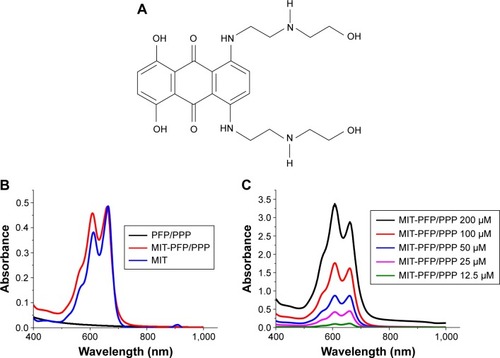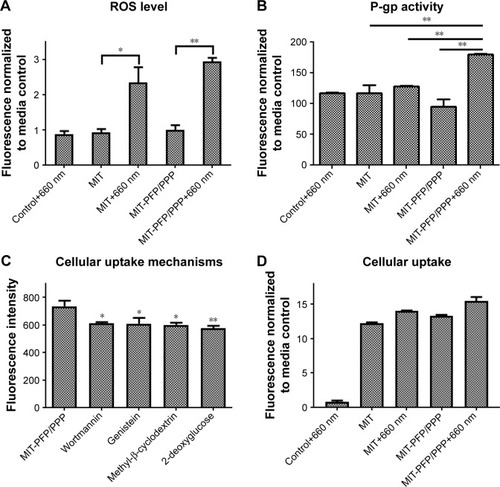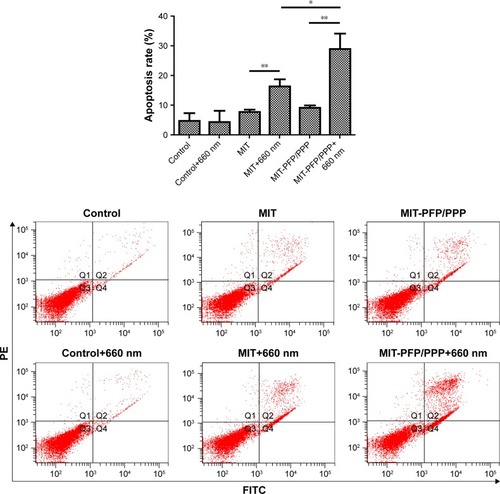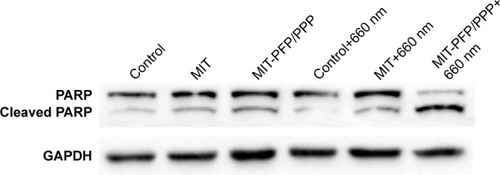Figures & data
Figure 1 Chemical structure of MIT and photo absorption properties of MIT and MIT-PFP/PPP mixed micelles.
Notes: (A) The chemical structure of MIT; (B) photo absorption properties of MIT, MIT-PFP/PPP mixed micelles and blank PFP/PPP mixed micelles, measured by DR6000 UV–visible spectrophotometer at the wavelength range of 400–1,000 nm; (C) photo absorption properties of MIT-PFP/PPP mixed micelles with different concentrations measured by DR6000 UV–visible spectrophotometer at the wavelength range of 400–1,000 nm. These experiments were carried out in triplicate.
Abbreviations: MIT, mitoxantrone; PFP, poly(ε-caprolactone)-pluronic F68-poly(ε-caprolactone); PPP, poly(d,l-lactide-co-glycolide)–poly(ethylene glycol)–poly(d,l-lactide-co-glycolide).

Figure 2 Cell viability of free MIT and MIT-PFP/PPP mixed micelles in MCF-7/ADR cells with or without laser irradiation at the power of 6, 12 and 24 mW for 0.5 h with a 660 nm fiber-coupled laser system (mean ± SD, n=3).
Abbreviations: MIT, mitoxantrone; PFP, poly(ε-caprolactone)-pluronic F68-poly(ε-caprolactone); PPP, poly(d,l-lactide-co-glycolide)–poly(ethylene glycol)–poly(d,l-lactide-co-glycolide).

Figure 3 ROS levels, P-gp activity, cellular uptake mechanisms and cellular uptake of free MIT and MIT-PFP/PPP mixed micelles with or without irradiation at the power of 24 mW for 0.5 h with a 660 nm fiber-coupled laser system in MCF-7/ADR cells (mean ± SD, n=3).
Notes: (A) ROS levels were determined by a ROS assay kit with fluorescent analysis by flow cytometry. (B) P-gp activity was detected by a multidrug resistance assay kit. (C) Cellular uptake mechanisms were determined by preincubation with different endocytic inhibitors and (D) intracellular uptake was detected by measuring the fluorescence of mitoxantrone associated with the cells by flow cytometry. *P<0.05 and **P<0.01.
Abbreviations: MIT, mitoxantrone; PFP, poly(ε-caprolactone)-pluronic F68-poly(ε-caprolactone); PPP, poly(d,l-lactide-co-glycolide)–poly(ethylene glycol)–poly(d,l-lactide-co-glycolide); P-gp, P-glycoprotein; ROS, reactive oxygen species.

Figure 4 Nuclear staining by Hoechst 33342 in MCF-7/ADR cells treated with MIT and MIT-PFP/PPP mixed micelles with or without laser irradiation at the power of 24 mW for 0.5 h with a 660 nm fiber-coupled laser system.
Notes: The experiments were carried out in triplicate. The arrows indicate nuclear morphologic changes and chromosome condensation.
Abbreviations: MIT, mitoxantrone; PFP, poly(ε-caprolactone)-pluronic F68-poly(ε-caprolactone); PPP, poly(d,l-lactide-co-glycolide)–poly(ethylene glycol)–poly(d,l-lactide-co-glycolide).

Figure 5 Apoptotic analysis by Annexin V-FITC/PI detection kit in MCF-7/ADR cells treated with MIT-PFP/PPP mixed micelles with or without laser irradiation at the power of 24 mW for 0.5 h with a 660 nm fiber-coupled laser system (mean ± SD, n=3).
Note: *P<0.05 and **P<0.01.
Abbreviations: FITC, fluorescein isothiocyanate; MIT, mitoxantrone; PE, phycoerythrin; PFP, poly(ε-caprolactone)-pluronic F68-poly(ε-caprolactone); PPP, poly(d,l-lactide-co-glycolide)–poly(ethylene glycol)–poly(d,l-lactide-co-glycolide).

Figure 6 Western blot analysis of PARP expression in MCF-7/ADR cells treated with MIT and MIT-PFP/PPP mixed micelles with or without laser irradiation at the power of 24 mW for 0.5 h with a 660 nm fiber-coupled laser system.
Note: The experiments were carried out in triplicate.
Abbreviations: MIT, mitoxantrone; PARP, poly ADP-ribose polymerase; PFP, poly(ε-caprolactone)-pluronic F68-poly(ε-caprolactone); PPP, poly(d,l-lactide-co-glycolide)–poly(ethylene glycol)–poly(d,l-lactide-co-glycolide).

